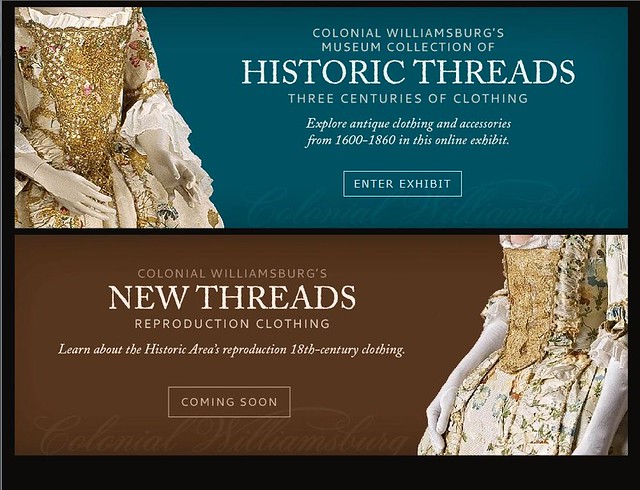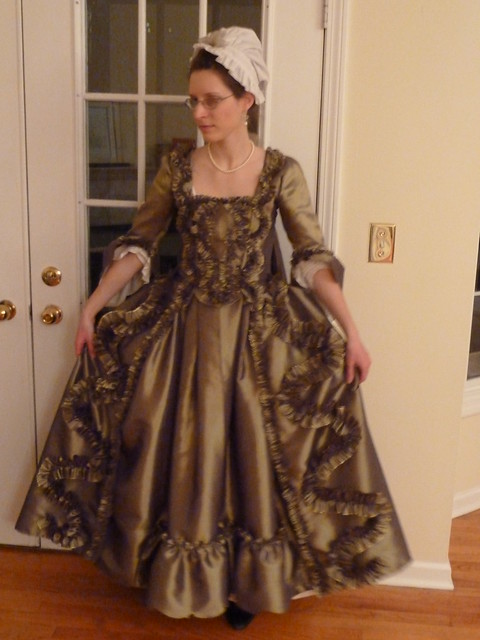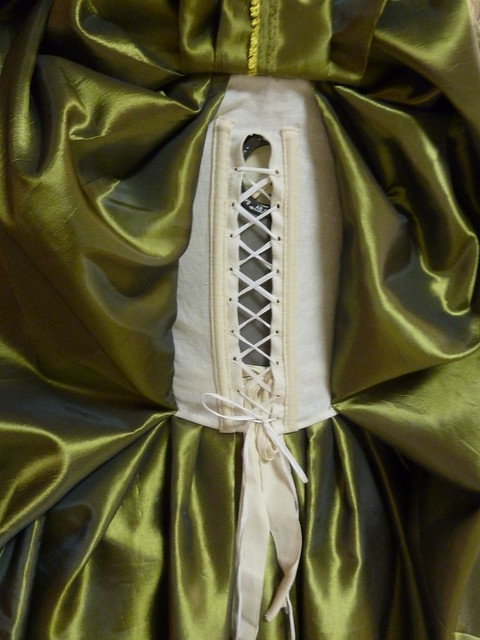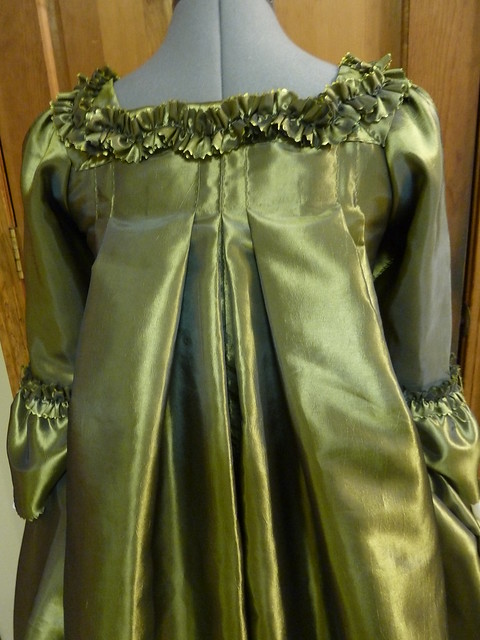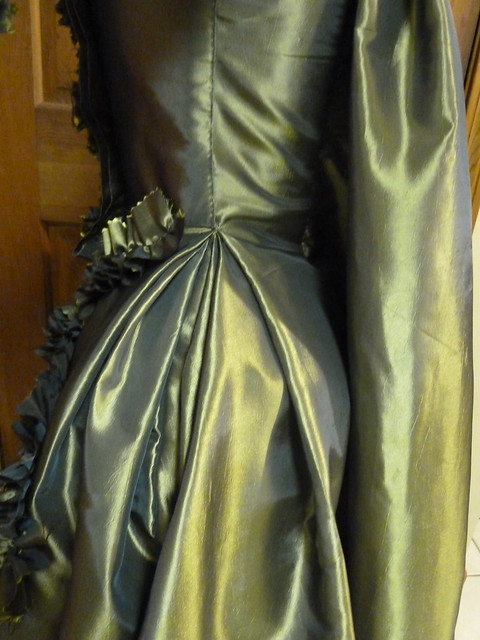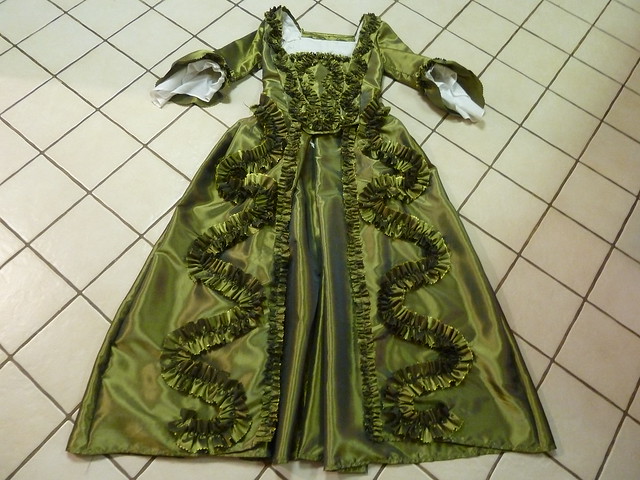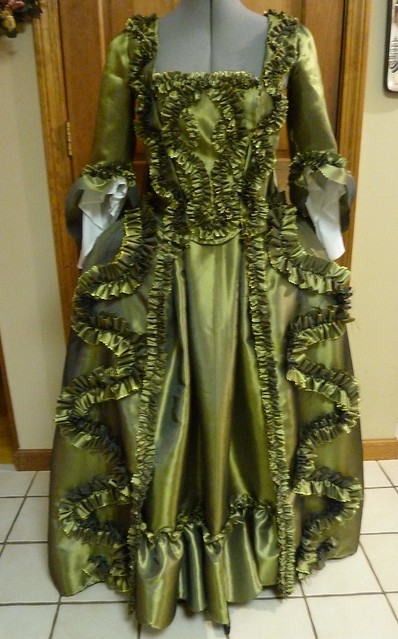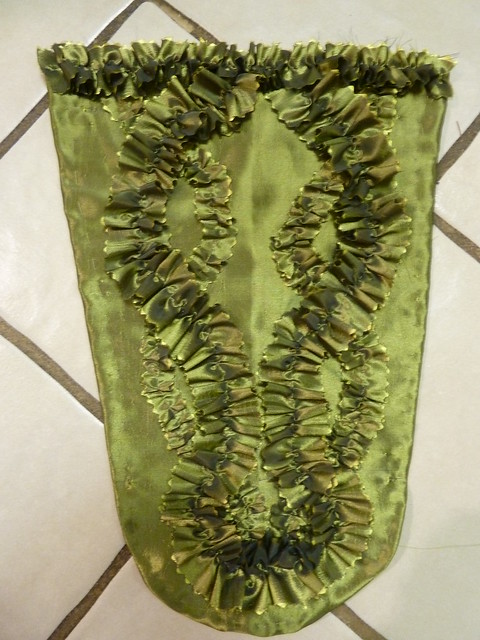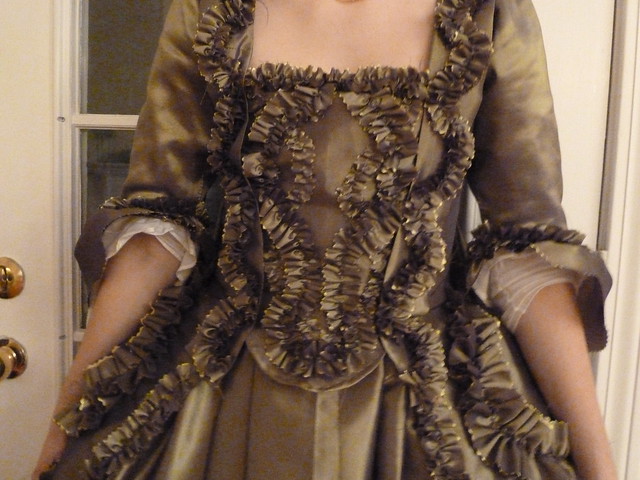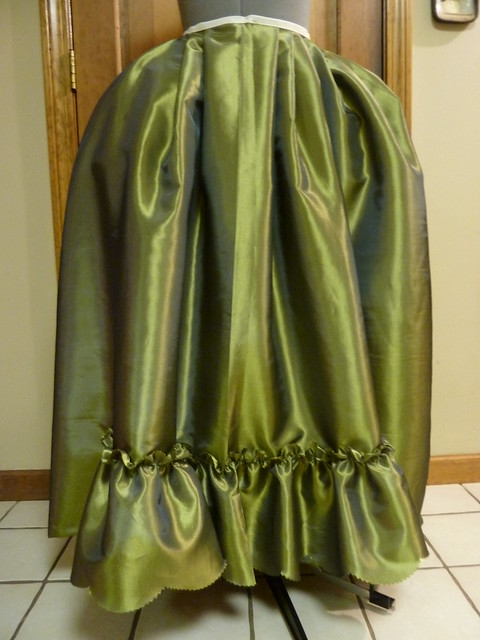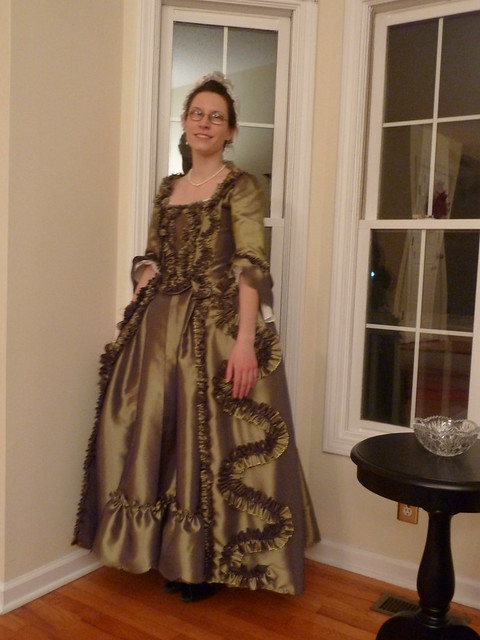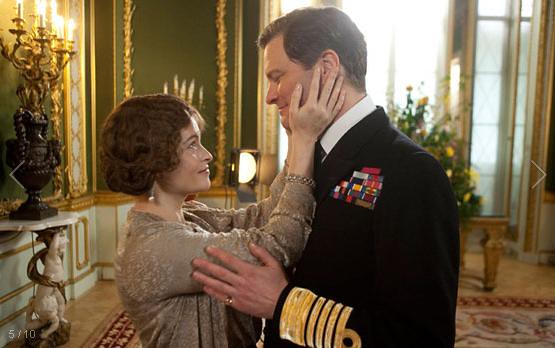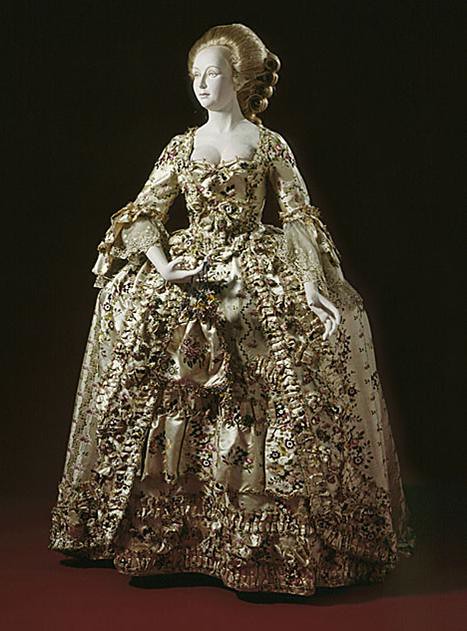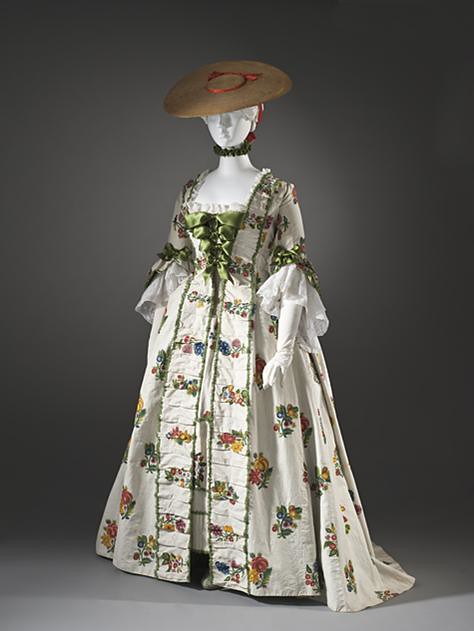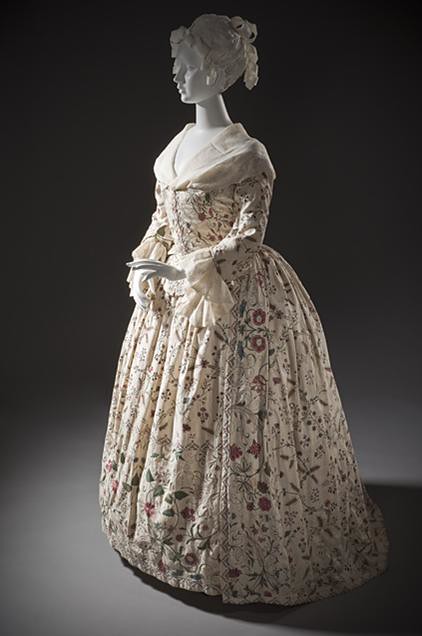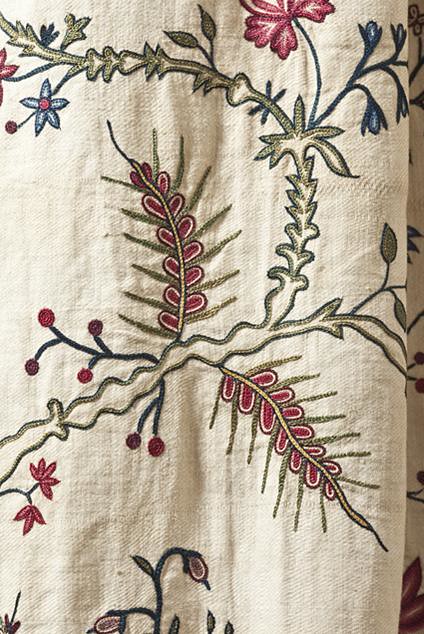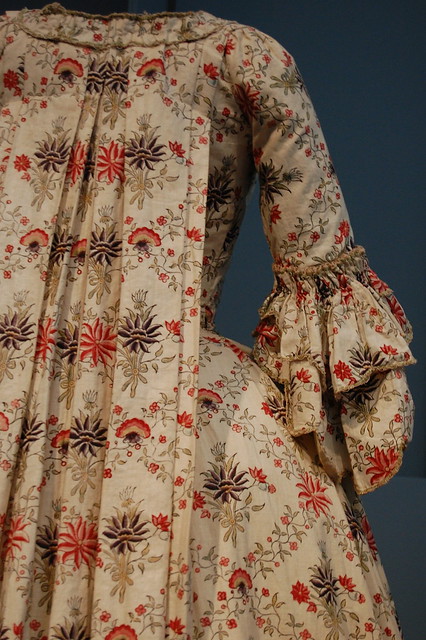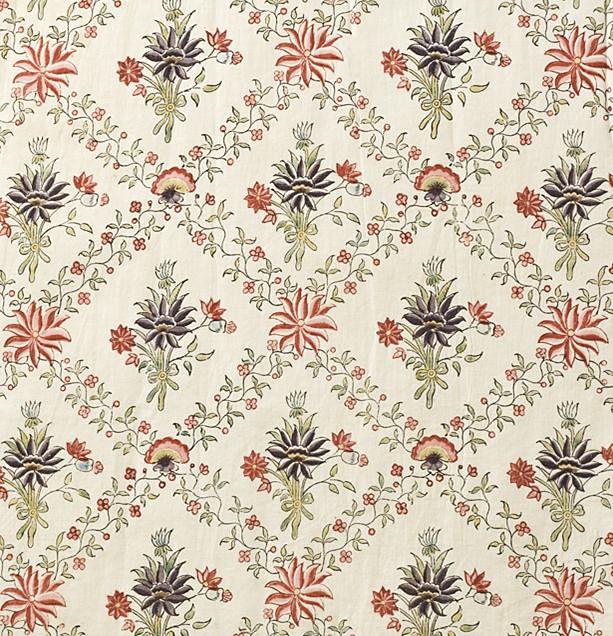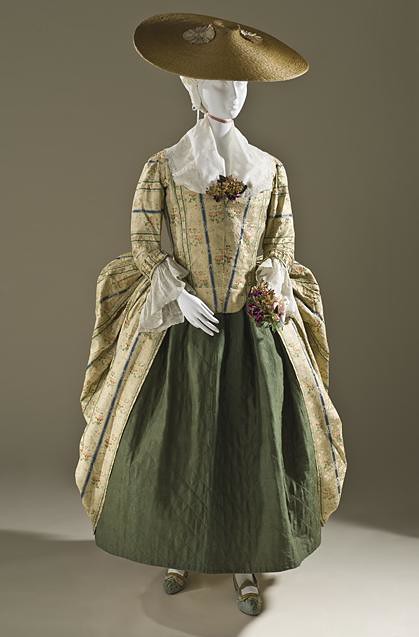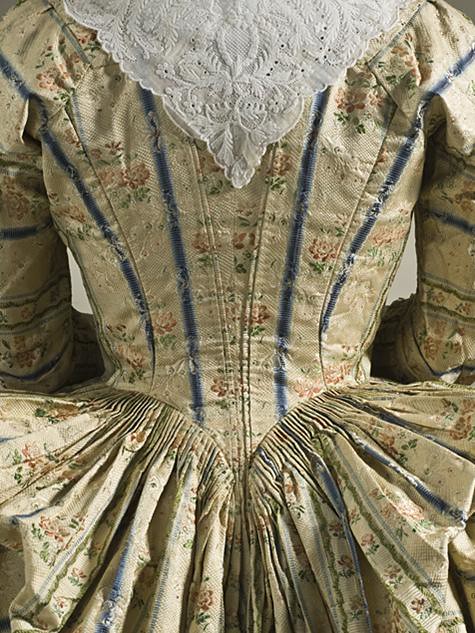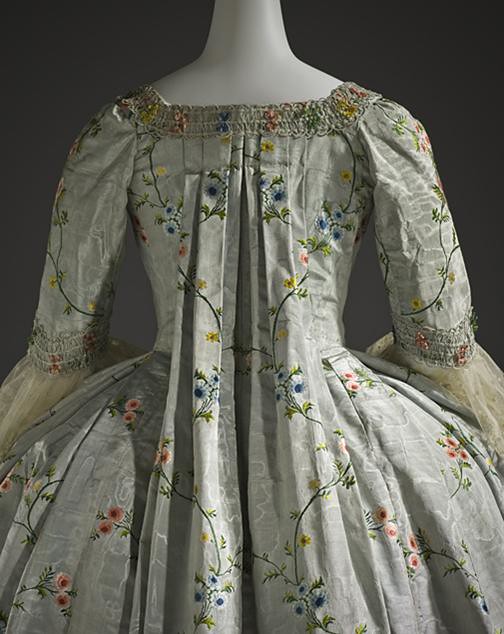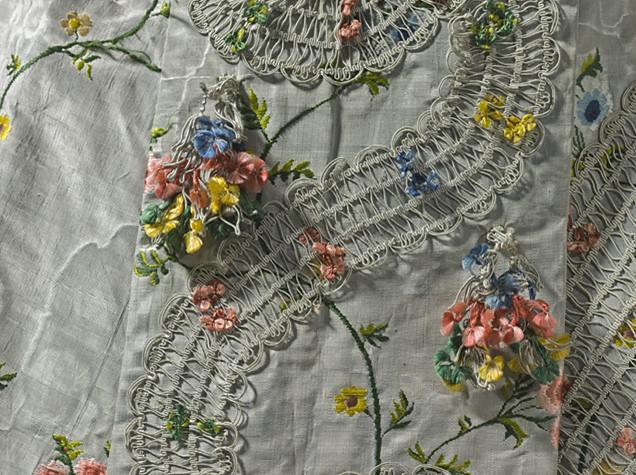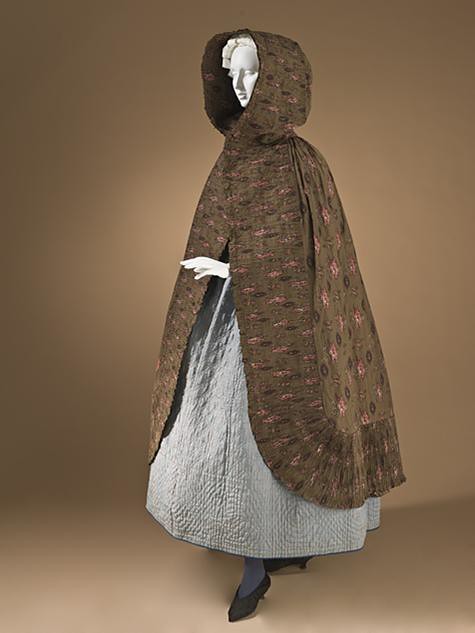This afternoon, Colonial Williamsburg launched a new online costume exhibit, "Historic Threads: Three Centuries of Clothing." Though only in its earliest of stages, the digital exhibit currently features a number of formal garments and accessories worn by women and men from the 17th through the early 19th centuries. Additional every-day functional clothing items will be posted to the exhibit soon. The online exhibit pages are formatted with splendid zooming capabilities to enable some truly stunning close-up views of all of the items featured. Also included are details on each item and a historical timeline that outlines the development of these fashionable and functional items across time.
"New Threads: Reproduction Clothing" will form the second half of this new online initiative, and will feature reproduction items produced by CW and used within the historic area. Keep checking back in with the exhibit page to see what promises to be another fantastic addition to period costuming resources!
This new online exhibit is the digital companion to "Fashion Accessories from Head to Toe: 1600 to 1840," the newest exhibit at CW's DeWitt Wallace Decorative Arts Museum, set to open on 29 January. It also features some clothing items displayed in the 2002 exhibit "The Language of Clothing." Enjoy!
Tuesday, January 25, 2011
Threaded Bliss
Blue and Yellow Changeable Taffeta
Robe a la Francaise (sacque back gown),
1765-1775
Ashley dressed in the gown for a recent ECD ball.
The Pattern: Draped by me directly on Ashley. Because this was my first draped sacque, I used the general shapes and seam placements of the pattern pieces from the gowns in Patterns of Fashion I, pgs. 34-5 and Costume Close-up, pgs. 16-22 as my guide as I cut and fit the fabric panels. The trim design is based on the serpantine curves from the Costume Close-up gown, which were fashionable from the 1760s into the beginning of the 1770s.
Construction Details: The gown is entirely hand-sewn. Alas, I forgot (again!) to take in-progress photos. It's just that I work by fits and starts, and never think to stop to snap some pictures when the urge to sew comes on! Next time I promise some in-progress pictures to help explain the construction steps! Mind you, this is not to claim any kind of authority with my draping or construction processes, as I am entirely self-taught, but it works well for me for the present, until I'm lucky enough to learn the real techniques from a professional. :-)
I started by fitting the linen lining, then split the back lining piece up the center back. Boning channels of cotton twill tape, boned with reed, and a row of eyelets were placed on either side of the slash to allow for greater flexibility in the size of the finished garment. This feature is frequently seen on sacque gowns (as well as on pet-en-l'airs), and I love using it because it makes fitting so much easier!
Center back lacing, which is concealed beneath the full
pleats of the gown's back panels. This allows the gown
to be adjusted after it has been donned by the wearer.
I then pleated the center back panels of the taffeta and secured them to the back lining along the top of the pleats with a strip of self-fabric. The pleats were then stitched down to the lining for about 4 inches from the top to help them maintain their shape as they fall loosely from the shoulders.
Back of the sacque with the secured pleats.
Next, I fit the front part of the gown, which was a teensy bit complicated because I had to account for the robings (the strips of fabric that run down the front, under which the stomacher is pinned) and because I had to do darts (completely period correct) just at the line at the top of the stays, hidden beneath the robings, to help shape the front pieces over the bust and shoulder. I also folded the front panels at the waistline to create a front waist seam, which I prefer to the smooth, single panel fronts more typical of earlier gowns. The front bodice pieces were then lapped and sewn to the back panels, and I pleated up the sides of the skirts to accomodate the side hoops.
The front waist seam, though it's mostly hidden by the
robings and all the trim!
Detail of the side pleats, which accomodate the
hoops worn at the hips.
I still haven't mastered the nack of draping sleeves, so I borrowed the sleeve pattern from the gown in Patterns of Fashion, modifying it slightly to fit the cut of my gown. The sleeve ends are finished with a single scalloped and pinked flounce and a strip of ruched and pinked self-fabric. I backstitched in the bottom half of the sleeve, then pleated the top of the sleeve cap to Ashley's shoulders while she had the gown on, and topstitched them down to the strip of linen lining covering the shoulder. I then covered them with the strip of taffeta that extended from the bodice front. More often than not in original gowns, an additional strip of fabric did not cover the pleated sleeve cap; only the robings were used to conceal it. When I cut the front pieces of the bodice, however, I made sure to allow for some extra fabric there, because I didn't trust my robings to cover everything completely!
The last step was the trim, whichby itself took just about as long as the assembly process, there was so much of it! I tacked on the robings down the front of the gown and along the back neckline
, and then covered them with a curved strip of pinked and ruched self-fabric. This same curve is echoed in the trim of the skirts, which also have a straight line of trim extending down the center fronts to frame the petticoat opening.
The stomacher is backed with linen and covered in the same kind of curved and ruched trim as the gown. Using the stomacher of this gown from the Met's collection as my inspiration, I first made one set of curves in a narrower trim. Then I overlaid those curves with curves moving in the opposite direction made of a slightly wider trim, which gives the stomacher a more three-dimensional appearance. The stomacher is secured to the gown front with straight pins, concealed beneath the robings.
Stomacher detail.
The petticoat is constructed of two panels, shaped at the waist to accomodate the fullness of the side hoops. As with both of my reference gowns' petticoats, this petticoat's ruffle only covers the center front of the front panel, so that only the exposed bit of the petticoat requires the use of this extra fabric. The bottom of the ruffle is scalloped and pinked to match the sleeve flounce.
The Fabric: This blue and yellow changeable taffeta gives the effect of green. In the low (mock!) candlelight of our recent English country dance ball, the gown took on a lovely goldish hue. It almost looks like two different gowns in the photos here; the real color falls right in between. Ashley purchased 9 1/2 yards of the 54" taffeta, and we ended up using all but about 1/2 a yard of it! The bodice is lined in a cream medium-weight linen to support all of the pleated fabric that hangs from it.
Finishing the Look: By the late 1760s and early 1770s, both the sacque gown and the extremely wide sillouette popular from the 1740s into the 1760s were gradually waning in popularity. Smaller side hoops replaced the wider hoop skirts, and were increasingly reserved for more formal gowns and occassions. My pocket hoops are drafted from the pattern in Corsets and Crinolines, but I scaled them down quite a bit to give the gown an upper-class, rather than strictly formal, function.
Side hoops, modeled by my dressform. I forgot to get a shot of them
on Ashley with the proper period underthings beneath!
In the ball photos, Ashley wears the gown over a shift and fully-boned stays, the side hoops, and a linen petticoat. White lawn flounces are tacked into the sleeves, and a white lawn cap embellished with olive green organza ribbon completes the finished look. Her hand-knotted pearl necklace is secured with a matching organza ribbon, and her reproduction pearl earrings are by Janice Erickson Smith of Historic Delights.
As always, if you would like to see more photos of this gown that couldn't fit into the post, check out the full photo set on flickr.
Monday, January 24, 2011
2011 Elm City Assembly
This past weekend we attended the Elm City Assembly, the annual English country dance ball hosted by the New Haven, CT ECD group. Our weekend of dance began on Friday night with our usual practice. After a few weeks away (due to the several winter storms we've been hit with lately) it was great to get back into the swing of things. We even got to dance Rebecca's favorite, "Fenterlarick" (thanks Peggy!). On Saturday, we had an afternoon workshop led by our ball's master of ceremonies, Bruce Hamilton, who traveled from California to be a part of our event. During the workshop, Bruce brought us through some of the dances on the list for the ball. Still being fairly new to ECD, it was a very helpful prep-session and a great opportunity to learn some new dances.
The ball was a wonderful event and a huge congratulations and thank you to the organizers and musicians! There were about 100 guests from Connecticut, New York, and other places nearby in New England. It was so fun to meet new fellow ECD dancers and to see everyone dressed up for the occasion! I had the opportunity to wear my new blue and yellow changeable taffeta sacque-back gown (Rebecca's post on that will be coming soon). There were a total of 20 dances on the program for the evening, varying in degrees of difficulty beginning at a level of moderate experience. Some of the dances were modern ECD constructions, but the majority were original to Playford or other 18th century dance masters. We both managed to keep up fairly well, although "Hambleton’s Round O" still manages to confuse me every time! I sat out a few of the more advanced dances, but loved watching everyone else swirl around the dance floor. After such a fun evening we are looking forward to more ECD balls in the spring!
The ball was a wonderful event and a huge congratulations and thank you to the organizers and musicians! There were about 100 guests from Connecticut, New York, and other places nearby in New England. It was so fun to meet new fellow ECD dancers and to see everyone dressed up for the occasion! I had the opportunity to wear my new blue and yellow changeable taffeta sacque-back gown (Rebecca's post on that will be coming soon). There were a total of 20 dances on the program for the evening, varying in degrees of difficulty beginning at a level of moderate experience. Some of the dances were modern ECD constructions, but the majority were original to Playford or other 18th century dance masters. We both managed to keep up fairly well, although "Hambleton’s Round O" still manages to confuse me every time! I sat out a few of the more advanced dances, but loved watching everyone else swirl around the dance floor. After such a fun evening we are looking forward to more ECD balls in the spring!
Monday, January 17, 2011
Finding a Voice: The King's Speech
Yesterday, we finally (finally!) managed to see The King's Speech, which we've been dying to get to ever since its Christmas release. After weeks of being teased by the tv previews that were the cruelest of taunts because it wasn't playing anywhere local, and then after another couple of weeks of being just-plain-too-busy to be able to go once it *was* playing nearby, we finally got ourselves (and our mother!) there. It was well worth the wait! The film is superb, beautifully filmed, and wonderfully understated. Definitely a must-see.
For those of you unfamiliar with the story, The King's Speech explores the relationship between King George VI (the father of the present Queen Elizabeth II, known to his family as "Bertie") and Lionel Logue, an unconventional speech therapist enlisted by Bertie's wife to help her husband learn to cope with a speech impediment that made public speaking for him a torturous experience. The film focuses on the years between 1925 and 1939, covering some of the world-altering events that demanded a very public reaction from Bertie.
The second son of King George V, Bertie only ever intended to live out his life in relative privacy with his wife and daughters. The scandalous 1936 abdication of his older brother, Edward VIII, however, demanded Bertie assume the throne and thrust him into a public spotlight he neither sought nor relished. As the newly crowned George VI, he was forced to confront the increasingly threatening situation with Hitler amidst a tide of popular opinion still decidedly in favor of his older brother - even in spite of Edward's thinly veiled Nazi sympathies. Recognizing the country's need of a strong and inspiring leader, George VI responded with a speech declaring war on Germany on the 3rd of September 1939 and urging courage, strength, and unity from his people in the face of the difficult times ahead. Logue stood by the king's side, assisting him through this and every subsequent wartime radio broadcast and public speech.
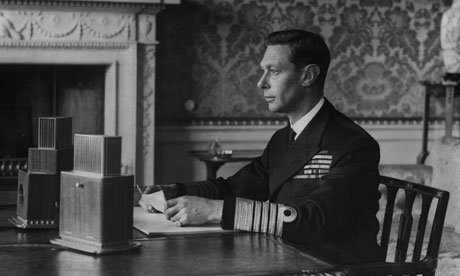
To hear the actual "king's speech" from 3 September 1939, click here. As the film explains, Logue helped George VI develop the steady, measured style that you hear, a technique that offered a way around the king's nervous stammer. In a NPR interview, the film's director, Tom Hooper, explained how he and Colin Firth (who plays George VI) watched and listened to hours of archival records of the king speaking, and were both "extremely moved" by the effort and pain the king's halting voice and expressions reveal. The pauses actually come across as quite dramatic in the original audio file, and you can hear the subtle influence of this speech style in the present queen's way of speaking in public, though she does not suffer from the same impediment as her father. You might say it became something of a royal trademark over the years, a sign of self-assured strength rather than weakness. After all, it was that voice that got Britain through World War II.
The film was nominated for seven Golden Globes, including Best Picture. Last night, Colin Firth was awarded the Best Actor title, a well-deserved honor for the thoughtfully moving performance he gave.
If you're interested in learning more about the real-life figures in this drama, check out the movie tie-in book, The King's Speech: How One Man Saved the British Monarchy, a biography of Logue co-written by his grandson and based on Logue's case notes from his meetings with Bertie. Several years ago, PBS also did a bio-pic about George VI and Queen Elizabeth called Bertie and Elizabeth, which is worth a watch. The 1936 abdication of Edward VIII, which brought George VI to the throne, has been the subject of numerous books and films; the best of these, I think, is a 1978 mini-series, Edward and Mrs Simpson, though there have been several more recent dramatizations of the story.
For those of you unfamiliar with the story, The King's Speech explores the relationship between King George VI (the father of the present Queen Elizabeth II, known to his family as "Bertie") and Lionel Logue, an unconventional speech therapist enlisted by Bertie's wife to help her husband learn to cope with a speech impediment that made public speaking for him a torturous experience. The film focuses on the years between 1925 and 1939, covering some of the world-altering events that demanded a very public reaction from Bertie.
The second son of King George V, Bertie only ever intended to live out his life in relative privacy with his wife and daughters. The scandalous 1936 abdication of his older brother, Edward VIII, however, demanded Bertie assume the throne and thrust him into a public spotlight he neither sought nor relished. As the newly crowned George VI, he was forced to confront the increasingly threatening situation with Hitler amidst a tide of popular opinion still decidedly in favor of his older brother - even in spite of Edward's thinly veiled Nazi sympathies. Recognizing the country's need of a strong and inspiring leader, George VI responded with a speech declaring war on Germany on the 3rd of September 1939 and urging courage, strength, and unity from his people in the face of the difficult times ahead. Logue stood by the king's side, assisting him through this and every subsequent wartime radio broadcast and public speech.

King George VI on 4 September 1939, the day after "the king's speech"
that declared war on Germany.
To hear the actual "king's speech" from 3 September 1939, click here. As the film explains, Logue helped George VI develop the steady, measured style that you hear, a technique that offered a way around the king's nervous stammer. In a NPR interview, the film's director, Tom Hooper, explained how he and Colin Firth (who plays George VI) watched and listened to hours of archival records of the king speaking, and were both "extremely moved" by the effort and pain the king's halting voice and expressions reveal. The pauses actually come across as quite dramatic in the original audio file, and you can hear the subtle influence of this speech style in the present queen's way of speaking in public, though she does not suffer from the same impediment as her father. You might say it became something of a royal trademark over the years, a sign of self-assured strength rather than weakness. After all, it was that voice that got Britain through World War II.
The film was nominated for seven Golden Globes, including Best Picture. Last night, Colin Firth was awarded the Best Actor title, a well-deserved honor for the thoughtfully moving performance he gave.
If you're interested in learning more about the real-life figures in this drama, check out the movie tie-in book, The King's Speech: How One Man Saved the British Monarchy, a biography of Logue co-written by his grandson and based on Logue's case notes from his meetings with Bertie. Several years ago, PBS also did a bio-pic about George VI and Queen Elizabeth called Bertie and Elizabeth, which is worth a watch. The 1936 abdication of Edward VIII, which brought George VI to the throne, has been the subject of numerous books and films; the best of these, I think, is a 1978 mini-series, Edward and Mrs Simpson, though there have been several more recent dramatizations of the story.
Sunday, January 16, 2011
Treasures and Curiosities from...
The Los Angeles Country Museum of Art
To mark their current exhibition, Fashioning Fashion: European Dress in Detail, 1700-1915, which will be on view until 6 March 2011, this month's "Treasures and Curiosities" come from the Los Angeles County Museum of Art. The museum recently acquired a significant collection of 250 garments and 300 accessories dating from the eighteenth and nineteenth centuries, which has brought its collection to the forefront of museum fashion and costume holdings (you can read the official press release describing the acquisition here). In addition to these newest pieces, the LACMA owns a superb range of over 20,000 items of clothing, accessories, and other textiles dating from the seventeenth to the twenty-first century. Please note that the selections below (as always) are representative of only the eighteenth century part of the collection. At some point, we plan to return to each of the collections we've profiled thus far and look at nineteenth-century items, but for now, it's all about the eighteenth century!
One of the neat things about the LACMA website is that they offer four PDF patterns of gentleman's garments dating from 1700-1795. There is currently no mention of any intention to pattern additional items from the collection (and these are obviously some of the simplest items to capture shape-wise), but we'll live in hope of more in the future!
Unless otherwise noted, the following images are borrowed from, and linked directly back to, the website of the Los Angeles County Museum of Art and originate entirely from their digital collections database. They remain the full and copyrighted property of the LACMA. All images are used for private educational purposes only, without any monetary gain whatsoever, and no copyright infringement is intended.
For some additional (stunning) photographs of these and many other gorgeous items currently on display, be sure to visit Katherine's (Koshka the Cat) flickr photostream from her visit to the exhibit; these are the best we've found online thus far. Additional reviews and photographs from the exhibition can be found on Marshall Astor's flickr photostream, Victoriana Magazine, Fashion Inquisitive, Eclectia Adornments, and Ciao Domenica, If you have photos from the exhibit that you'd like us to link to, just send us an email!
Our LACMA Top Ten:
Number One: Robe a l'Anglaise of brocaded silk satin with matching stomacher and petticoat, English or French, 1750-1770 (acquisition number: M.57.24.5a-c). The silk is embroidered with a pattern of bouquets. The ensemble is elaborately decorated with ruched self-fabric trim, self-fabric bows, and fly fringe (or just plain "fringe" if you prefer the 18th-century name!).
I wish I could find some close-up detail shots of the trim because it really is amazing, isn't it?
Number Two: Robe a la Francaise, France, 1760 (acquisition number: M.60.36.1). The gown is made of silk chine, which creates the "watered" look to the pattern (click here for a note on silk chine and another example of it from a previous post).
A detail of the sleeve. Note the pinked and punched finish.
Number Three: A French robe a la Francaise of linen with crewel embroidery, 1760 (textile dates to 1750) (acquisition number: M.90.83a-b). The trim is a serpantine looped tread design, and the stomacher and sleeves are embellished with silk satin ribbons.
From afar, the textile's pattern appears to be a printed one. The amount of detail in the embroidery is just incredible. I can't even begin to imagine the amount of time it must have taken to embroider the full gown-length's worth of fabric!
Photo linked from koshka the cat's flickr photostream.
For more detail shots of this gown from the current Fashioning Fashion exhibit, see Katherine's flickr set here: 1, 2, 3, 4, 5.
Number Four: A cotton twill robe a la Francaise with matching petticoat, England, 1760-1770 (acquisition number: M.66.31a-b). The textile's pattern is made with chain-stitch embroidery, so neat and fine that, like the above example, it truly looks printed. Absolutely amazing!
A detail of the chain-stitched embroidery.
Number Five: Robe a la Francaise, France, 1770 (acquisition number: M.2007.211.718). The gown is made with a block-printed cotton and decorated with silk braid.
A detail of the compere (false stomacher) front.
Photo linked from koshka the cat's flickr photostream
A detail of the block-printed cotton used for the gown.
Now, why can't someone reproduce period prints like this
for us costumers to use?!
For more images of this gown from the Fashioning Fashion exhibit, see Katherine's flickr set here: 1, 2, 3, 4, 5.
Number Six: A French silk gown, 1775 (acquisition number: M.70.85). The gown is worn paired with a quilted silk petticoat from the same period.
The museum catalog lists this as a robe a la polonaise, but it is clear from the detail photographs of the back that it is an English back gown (robe a l'anglaise) with the skirts worn draped up with tapes "a la polonaise," and not a polonaise in the strictest sense. You can see the tiny inverted en fourreau pleats below.
For additional photos of this ensemble from the Fashioning Fashion exhibit, see Katherine's flickr set here: 1, 2, 3, 4, 5, 6, 7.
Number Seven: A patterned silk faille robe a la Francaise, 1775 (acquisition number: M.2007.211.926a-b).
Photo linked from koshka the cat's flickr photostream.
The gown is intricately trimmed with silk passementerie and fly fringe that coordinates with and complements the woven floral pattern of the textile. The gown features a center-front closure, not particularly common with sack back gowns.
For additional close-up images of this gown, see Katherine's flickr photos here: 1, 2, 3, 4, 5, 6, 7, 8.
Number Eight: A riding habit of watered silk, Italy, 1780 (acquisition number: M.82.16.2a-c), embellished with silver trim and buttons. The skirts of the habit open at the front and back, with drawstrings at the side seams. The waistcoat, cuffs, and lapels are also of cerise watered silk (source: An Elegant Art, pg. 172).
Number Nine: Hooded cape, France, 1785-1820 (acquisition number: M.2007.211.669). The textile is a copper-plate and roller-printed indienne cotton. Its dark ground was popular in the last two decades of the 18th century and into the beginning of the 19th, and was called a "ramoneur" (chimney sweeper) print.
There is no information on the LACMA online listing to indicate how the cloak is lined, but Fashioning Fashion shows an interior view that reveals it to be lined in three different cotton prints (pg. 70). Because of the thinness of the cotton fabric, cotton print cloaks like this were typically lined in either a different cotton print or in wool. A strikingly similar cotton dark-ground print cloak in the Kyoto collection (AC4236 82-12-6) is lined with a smaller cotton print that features a white background, quite like one of three prints that lines the LACMA cloak. Both cloaks also feature the same wide and very closely pleated trim along the edges of the hood and body. See Fashion: A History, page 105, for a detailed view of the KCI cape's trim and printed lining.
Photo linked from small medium large blog.
For more images of this cloak, see Katherine's flickr photos photos here: 1, 2, 3, 4, 5.
Number Ten: Silk satin shoes, England, 1793-7 (acquisition number: M.59.24.29a-b). These fabulous little low-heeled slippers are made of silk satin, lined with leather, and are decorated with sequins and metallic passementerie. Oh, to have been Jane Austen...
Printed Resources Featuring Items from the 18th century part of the Los Angeles Country Museum of Art's collection:
- If your interest has been stirred by these images (and if you haven't already bought it!), I strongly encourage you to invest in the best printed resource for photographs and information on the LACMA collection, which is its newest publication, Fashioning Fashion, the catalogue for the current exhibition. The catalogue is in a superb large format with loads of detailed item descriptions and photos, all in full color, and is definitely worth the price.
- Another excellent and beautifully illustrated volume featuring the 18th-century part of the collection of the LACMA is An Elegant Art: Fashion and Fantasy in the Eighteenth Century, the catalogue that accompanied a 1983 exhibition. Along with lovely photos of garments, accessories, and textiles, the book also features numerous period paintings and prints, and includes seven essays on subjects ranging from woven silk and lace to embroidery to movement and fancy dress. Used copies can be had very cheaply, so snap one up while you can!
- Fabric and Fashion: Twenty Years of Costume Council Gifts, by Mary Kahlenberg, is another exhibit catalogue that features several period garments. Published in 1974, it unfortunately only includes black and white photos. I haven't actually seen a copy, though, so I can't comment on the detail of the photos or descriptions. If anyone else has had the chance to see it, I'd be interested to hear what's included.
Friday, January 7, 2011
Sewing for the Literary-Minded
Just before Christmas, while doing a little online holiday shopping, I discovered that the Sullivan Films shop offers for sale a pattern from Anne of Green Gables: The Continuing Story movie. It is Anne's wedding dress, a simple yet elegant gown inspired by a 1916 Canadian catalog wedding dress (because, if you recall, Anne's hurried wedding in the film necessitated the purchase of something pre-made).
My version of this dress will not be for a wedding; instead, I'm thinking perhaps either black (the sheer sleeves would look so pretty!) or a pastel color to make it a pretty springy outfit. With a hat, of course. Must have a hat.
I emailed the company to inquire if there were currently any plans to release any other patterns of costumes from the two earlier films, but they replied in the negative. Perhaps if we bombard them with inquiries so that they know there's plenty of interest, we can stir something up! I know I, for one, would love to get my hands on a pattern for Anne's "Gibson Girl" dress from Anne of Avonlea (er, Anne of Green Gables: The Sequel, if you prefer!), or that gorgeous gown she wears to the opera on her visit to Boston, or...well, I'd be happy with whatever they could offer!
Because of the timeline shift in the first Anne film, Kevin Sullivan had to bring the third up to the period of World War I. In the movie world, then, Anne and Gilbert don't marry until 1915, while in the book (Anne's House of Dreams), their wedding takes place around 1890, and it is not until the eighth volume in the series (Rilla of Ingleside) that L.M. Montgomery reaches the war years, by which time the main character has become Anne and Gilbert's youngest daughter.
Lucy Maud Montgomery (Anne's creator) and Ewan Macdonald were married on 5 July 1911, closer in date to the movie Anne and Gilbert than their original literary counterparts. We visited Prince Edward Island several times back in the mid-90s, and saw LMM's wedding gown on display at her birthplace in New London, and also visited the parlor room where she was married at her cousins the Campbells' home at Park Corner. Descendants of LMM still own the Park Corner property and permit wedding ceremonies to be conducted before the very same fireplace where LMM stood on her wedding day (and yes, all of the original furniture is still there, too). All three years we visited the house, there were couples having wedding pictures taken on the grounds.
LMM's wedding gown on display at the LMM Birthplace.
Photo linked from Reverand Sam's flickr photostream.
LMM recorded in her journal that "my wedding dress was of white-silk crepe de soie with tunic of chiffon and pearl bead trimming - and of course the tulle veil and orange blossom wreath." She also wore "Ewan's present - a necklace of of amethysts and pearls. My bouquet was of white roses and lilies of the valley" (The Selected Journals of L.M. Montgomery, Vol II, pgs. 64-7). Interestingly, these same materials - white silk de soie with a chiffon overdress decorated with bead trimming - were also used to create Anne's movie wedding dress, though in a much more "modern" style.
Photograph of LMM's wedding gown. The gown is
the property of the LMM Birthplace. The photo is
copyrighted by the LMM Institute.
The gown was made by Margaret Bulman of New Glasgow, PEI. We visited well before the age of digital cameras, and the photos we have are so badly lit you can't make out what's in them, so I've had to link to online images instead.
Montgomery also wrote about the enjoyment she and her Park Corner cousins derived from the arrival of her trousseau, which the hard-earned funds from her newly-published novels had enabled her to order all the way from Toronto and Montreal. She modelled them proudly as her cousin snapped photographs, and later inserted the photos into one of her scrapbooks. Swatches of some of the fabrics were also carefully saved there, along with some flowers from her bouquet. Click here for a brief but very neat little video from the L.M. Montgomery Institute showing the scrapbook page. I remember seeing some of LMM's scrapbooks on display at her New London Birthplace and at the PEI Confederation Centre of the Arts, but I don't recall seeing this particular one. Guess I'll just have to go back again!
Some of the photos are below, and she described the outfits thus in her journal: "My trousseau, which I had made mainly in Toronto and Montreal, began to arrive and we were all interested in that. My things were pretty...These are snaps the girls took of some of my dresses. My suit was of steel gray cloth, with gray chiffon blouse and gray hat trimmed with a wreath of tiny rosebuds. My long wrap was of gray broadcloth. Besides the dresses 'illustrated' I had a linen dress, a pink muslin, one of white embroidery, and several odd waists" (The Selected Journals of L.M. Montgomery, Vol II, pgs. 64-6). If only they had survived as well as the wedding gown!
More images of the trousseau can be see in The Selected Journals of L.M. Montgomery, Vol. II, pg. 65.
For further information on all of these items, visit the Confederation Centre's "L.M. Montgomery's Wedding Clothes" page. The page is part of a larger project based on a recent exhibit of LMM's scrapbooks, called "Picturing a Canadian Life: L.M. Montgomery's Personal Scrapbooks and Book Covers." If you're interested in taking a closer look at some of the scrapbooks (which intriguingly contain many swatches and fashion clippings), check out Imagining Anne: The Island Scrapbooks of L.M. Montgomery, the book that accompanies the exhibit. Further information on the life and writings of L.M. Montgomery can be found through the L.M. Montgomery Institute.
Monday, January 3, 2011
"Fashion Accessories from Head to Toe": An Upcoming Exhibit at CW
Colonial Williamsburg published a vodcast today, Fashion Accessories from Head to Toe, featuring Linda Baumgarten, Curator of Textiles and Costume at CW. In the vodcast, she discusses the upcoming exhibit of the same name at the DeWitt Wallace Decorative Arts Museum, which will feature approximately 200 clothing accessories from the late 17th to early 19th centuries, from hats to shoes and everything in between. She also provides viewers with a peek at some of the pieces that will be displayed. The vodcast also offers another glimpse of the extraordinary work of the CW milliners and their recreation of "Spruce Sportsman, or Beauty the Best Shot," a 1777 fashion print. Photos of this project can be seen on the Margaret Hunter Shop's facebook page, and a fun behind-the-scenes look at the shooting of the "Spruce Sportsman" video (which will be featured in the exhibit) can be found on the Two Nerdy History Girls blog. The exhibit is set to open on January 29, 2011 and will run through December 31, 2012. With the added excitement of the CW costume accessories symposium in March, we are anxiously awaiting the opportunity to see this new exhibit!
Subscribe to:
Posts (Atom)

